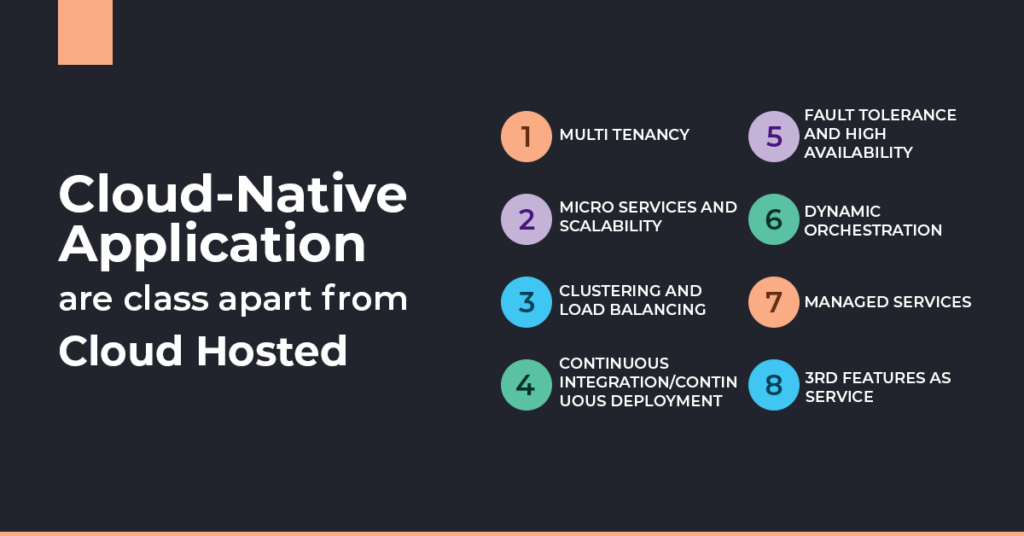Cloud-Native Application are class apart from Cloud Hosted Application

Many SAAS provider move traditional server to cloud and call it a cloud applications. From strict definition prospective it can be classified as a cloud application. Though this ‘lift and shift’ approach, while beneficial in some respects, doesn’t exploit the full potential of cloud computing. True cloud-native applications, designed specifically for cloud environments, go far beyond mere hosting—they embody the principles of cloud architecture to deliver superior flexibility, performance, and scalability. The designed as cloud-native applications are fundamentally different and superior, even when those are hosted on the same cloud platforms.
Shifting an existing web applications and data from on-premise servers to virtual machines of a cloud provider’s infrastructure are traditional cloud solution. This type of cloud applications, often termed ‘lift and shift,’ allows service provider to leverage some benefits of the cloud, such as reduced physical infrastructure maintenance and increased accessibility. However, this approach does not provide real capability of cloud native application. The application’s architecture remains like an in-premise web application. It doesn’t take any advantages of cloud-native features such as microservices, feature as a service, serverless computing, or dynamic orchestration etc.
Cloud-native applications are designed from the ground up to exist in a cloud environment. They take full advantage of cloud concepts and are built using services that are fully managed by cloud providers. These applications differ vastly in architecture and operations compared to their traditional counterparts. Let’s delve into the characteristics that make cloud-native applications superior:
– Multitenancy:
One of the powerful features of cloud-native applications is their support for multi-tenancy by design. Multi-tenancy allows a single instance of the application to serve multiple customers. This is achieved without sacrificing data isolation, performance, and security. This beings in many advantages for the application providers as well as end customer such as lower cost as the infrastructure is better utilised, design provides feature for customer specific customisation, as the same instance of application used by thousands of users security and reliability is better.
– Microservices and Scalability:
Cloud-native applications are typically structured as a collection of microservices. This modular approach makes them inherently scalable. Each microservice can be deployed, updated, scaled, and managed independently. Resource allocation is more efficient, and it’s easier to meet demand by scaling specific parts of an application rather than the whole monolith.
– Clustering and Load balancing:
A Good cloud native deployment is does not run on a single server. A series of server of deployed for different microservices. It automatically adds servers when the user load is high, at the same time resources are dynamically freed up when not required. This also provides capability to atomically switching to a alternate sever when one server fails for somme reason.
– Continuous Integration/Continuous Deployment (CI/CD):
With cloud-native application providers, leverage CI/CD technology to automate the testing and deployment of enhancements in the applications. Continuous delivery enables a nothing is disturbed when new feature is released and provides much faster deployment of bug fixing.
– Fault Tolerance and High Availability:
Cloud-native applications use software capability such as circuit breakers, bulkheads, and retries to handle failures and seamlessly switch to alternate infrastructure. This helps in high availability and minimises downtime.
– Dynamic Orchestration:
Cloud Native applications usages sophisticated orchestration software like Kubernetes in the articture, which manage the component life-cycle and micro-services. The efficiency of deployment, scaling, and containers management is seamless. This also helps in efficient use of resources.
– Managed Services:
Cloud-native applications takes advantage of many managed services such as databases, content library, bid-data service, in memory cache, messaging queues and AI/ML services. This helps the application provider to add new capability to the application at a much faster pace and much lower cost.
-3rd Features as service:
Cloud Native application not only make API calls to 3rd party service providers. It can also consume part of 3rd party feature as a native part of the application. This helps the customer in quickly adding features to the applcation without going through heavy customisation. This also enables much easier application to application integration with other cloud native applications.
Traditional web applications can suffer from inherent scalability issues and may not be architected for native cloud. When such applications are hosted on the cloud, they often fail to cope with the dynamic nature of cloud services, resulting in inferior performance and causes disruption to business.
The cloud native application such as Proteus Vision ERP https://www.proteustech.in are designed to excel in the cloud ecosystem. They provide businesses with the agility and innovation required to compete in market conditions. Selecting a cloud-native applications not just a good technology choice, but also a strategic business decision that can help the organisation succeed in their business objectives.